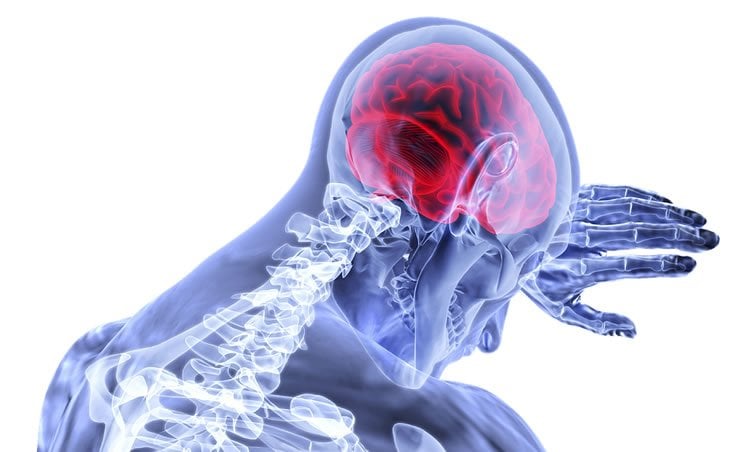Summary: A new study reports on a link between age, body mass index and brain integrity in psychosis. Researchers discovered higher age, BMI and severity of psychotic symptoms were negatively associated with cortical thickness and brain activity when patients were asked to perform cognitive tasks.
Source: Mount Sinai.
Mount Sinai researchers have shown, for the first time, the complex web of links between physical and behavioral characteristics, like age, body mass index (BMI), and substance use, and specific patterns of brain structure and function in patients with psychosis. The study is important because many of these characteristics can be targeted clinically to improve brain health in these patients.
The researchers found, among other things, that brain health declines as age, BMI, and substance use increase. Buthigher IQs were positively associated with multiple measures of brain health in people with psychosis.
The results of the study will be published online in JAMA PSYCHIATRY on Wednesday, March 7.
Psychosis is a term used to describe severe mental disorders characterised by symptoms in which an individual has sensory experiences of things that do not exist or beliefs with no basis in reali-ty. Approximately 100,000 people experience psychosis each year in the United States and as many as 3 in 100 people will have an episode at some point in their lives. The findings of this study have important implications for clinical care as they identify multiple modifiable factors that can be targeted to improve brain health in patients with psychosis.
The research team, led by Sophia Frangou, MD, PhD, Professor of Psychiatry, Icahn School of Medicine at Mount Sinai, examined data from 140 patients diagnosed with psychosis. They took high-resolution MRI brain scans to measure brain volume, cortical thickness, connections between brain regions, and connectivity of brain regions during mental tasks. The team then used a statistical method called sparse canonical correlation to discover the relationships between these features of brain integrity and measures of age, cognitive ability, BMI, substance use, physical activity, psychological trauma, family history of mental problems, and symptom severity. They found that higher age, higher BMI, and more severe psychotic symptoms were negatively associated with cortical thickness and brain activation during mental tasks. Conversely, higher IQ showed positive associations. In addition, substance use was negatively associated with measures of brain volume and brain wiring.

“These new results provide new insights on the many factors that influence brain integrity in patients with psychosis and provide evidence for the need for integrated physical and cognitive interventions in addition to psychiatric care,” said Dr. Frangou.
“Patients with psychosis often have multiple health problems that impair their daily function and reduce life expectancy compared to the general population. Improving physical well-being and brain health should be the two pillars of clinical care for patients with psychosis.”
Source: Mount Sinai
Publisher: Organized by NeuroscienceNews.com.
Image Source: NeuroscienceNews.com image is in the public domain.
Original Research: Abstract in JAMA Psychiatry.
doi:10.1001/jamapsychiatry.2017.4741
[cbtabs][cbtab title=”MLA”]Mount Sinai “Study Links Physical Characteristics and Brain Health in Psychosis.” NeuroscienceNews. NeuroscienceNews, 14 March 2018.
<https://neurosciencenews.com/psychosis-physical-brain-8636/>.[/cbtab][cbtab title=”APA”]Mount Sinai (2018, March 14). Study Links Physical Characteristics and Brain Health in Psychosis. NeuroscienceNews. Retrieved March 14, 2018 from https://neurosciencenews.com/psychosis-physical-brain-8636/[/cbtab][cbtab title=”Chicago”]Mount Sinai “Study Links Physical Characteristics and Brain Health in Psychosis.” https://neurosciencenews.com/psychosis-physical-brain-8636/ (accessed March 14, 2018).[/cbtab][/cbtabs]
Abstract
Multivariate Associations Among Behavioral, Clinical, and Multimodal Imaging Phenotypes in Patients With Psychosis
Importance Alterations in multiple neuroimaging phenotypes have been reported in psychotic disorders. However, neuroimaging measures can be influenced by factors that are not directly related to psychosis and may confound the interpretation of case-control differences. Therefore, a detailed characterization of the contribution of these factors to neuroimaging phenotypes in psychosis is warranted.
Objective To quantify the association between neuroimaging measures and behavioral, health, and demographic variables in psychosis using an integrated multivariate approach.
Design, Setting, and Participants This imaging study was conducted at a university research hospital from June 26, 2014, to March 9, 2017. High-resolution multimodal magnetic resonance imaging data were obtained from 100 patients with schizophrenia, 40 patients with bipolar disorder, and 50 healthy volunteers; computed were cortical thickness, subcortical volumes, white matter fractional anisotropy, task-related brain activation (during working memory and emotional recognition), and resting-state functional connectivity. Ascertained in all participants were nonimaging measures pertaining to clinical features, cognition, substance use, psychological trauma, physical activity, and body mass index. The association between imaging and nonimaging measures was modeled using sparse canonical correlation analysis with robust reliability testing.
Main Outcomes and Measures Multivariate patterns of the association between nonimaging and neuroimaging measures in patients with psychosis and healthy volunteers.
Results The analyses were performed in 92 patients with schizophrenia (23 female [25.0%]; mean [SD] age, 27.0 [7.6] years), 37 patients with bipolar disorder (12 female [32.4%]; mean [SD] age, 27.5 [8.1] years), and 48 healthy volunteers (20 female [41.7%]; mean [SD] age, 29.8 [8.5] years). The imaging and nonimaging data sets showed significant covariation (r = 0.63, P < .001), which was independent of diagnosis. Among the nonimaging variables examined, age (r = −0.53), IQ (r = 0.36), and body mass index (r = −0.25) were associated with multiple imaging phenotypes; cannabis use (r = 0.23) and other substance use (r = 0.33) were associated with subcortical volumes, and alcohol use was associated with white matter integrity (r = −0.15). Within the multivariate models, positive symptoms retained associations with the global neuroimaging (r = −0.13), the cortical thickness (r = −0.22), and the task-related activation variates (r = −0.18); negative symptoms were mostly associated with measures of subcortical volume (r = 0.23), and depression/anxiety was associated with measures of white matter integrity (r = 0.12).
Conclusions and Relevance Multivariate analyses provide a more accurate characterization of the association between brain alterations and psychosis because they enable the modeling of other key factors that influence neuroimaging phenotypes.







